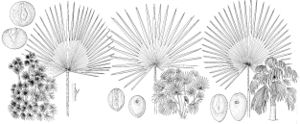Livistona
Prodr. 267. 1810.
| Taxon | Illustrator ⠉ | |
|---|---|---|
 | Serenoa repens Livistona chinensis Acoelorraphe wrightii |
Plants small to large. Stems solitary, erect, slender (rarely) to robust (more than 20 cm diam.), at first covered by persistent leaf-sheaths, later becoming bare or covered with persistent petiole bases, ringed conspicuously or obscurely with leaf-scars. Leaves: petiole not split at base, strongly armed [unarmed]; abaxial hastula minute or absent; adaxial hastula conspicuous; blade palmate or costapalmate; plication induplicate; segments basally connate, lanceolate, not producing fibers between segments. Inflorescences axillary within crown of leaves, paniculate with 3–5 orders of branching, about as ± as long as leaves; prophyll membranaceous; peduncular bracts many, obscuring rachis; rachillae pubescent. Flowers bisexual [unisexual], borne singly along rachillae [in small groups]; perianth 2-seriate; calyx cupulate, 3-lobed; corolla 3-lobed, valvate; stamens 6, connate in short tube; gynoecium: pistils 3, distinct basally, glabrous; styles connate, slender. Fruits drupes; exocarp blackish, smooth; mesocarp fleshy; endocarp bony. Seeds globose or ellipsoid; endosperm homogeneous; embryo lateral; eophyll undivided, lanceolate. xn = 18.
Distribution
in Fla, West Indies, Bermuda, native to Asia, Africa, Pacific Islands, and Australia
Discussion
Species 25+ (2 in the flora).
Selected References
Lower Taxa
Key
| 1 | Inflorescences with 3 orders of branching; fruits oblong (rarely globose), ripening from green to blue-green | Livistona chinensis |
| 1 | Inflorescences with 5 orders of branching, immediately 3-forking to 3 equal main axes; fruits globose, ripening from green through orange to black | Livistona rotundifolia |